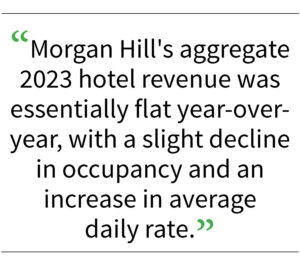Balance of Morgan Hill’s hotel market mix and performance will continue to evolve
![]()
By Krista Rupp

Krista Rupp
In 2016, the California Legislature designated May as California Tourism Month, spotlighting tourism’s role as a major economic driver. Visit California reports travel in the Golden State was a $134.4 billion industry in 2022, supporting 1.09 million jobs and generating $11.9 billion in state and local tax revenue.
In Morgan Hill, we are carving out our own piece of the tourism pie. Visit Morgan Hill is benchmarking its importance within our local economy through a soon-to-be-released Tourism Market Assessment report. The 16-page report reflects on the past four years and forecasts what’s ahead for the local hotel and tourism industry. Data sources include local tourism district collection figures, Smith Travel Research hotel metrics, Visa Insights credit card data, and Visit California’s Lodging Forecast.

Morgan Hill’s aggregate 2023 hotel revenue was essentially flat year-over-year, with a slight decline in occupancy and an increase in average daily rate. Observations from local hotelier anecdotes note glimmers of returning corporate accounts and new construction-related travel.
 Monthly income analysis shows summer revenue peaks attributed to outdoor events such as swim meets, tournaments, and an amalgamation of private group events. The absence of outdoor-venue dependent sports and events during the winter highlights the need for a well-rounded set of tourism experiences that support off-season hotel stays and merchant spending within the city.
Monthly income analysis shows summer revenue peaks attributed to outdoor events such as swim meets, tournaments, and an amalgamation of private group events. The absence of outdoor-venue dependent sports and events during the winter highlights the need for a well-rounded set of tourism experiences that support off-season hotel stays and merchant spending within the city.
In 2023, non-resident Visa card holders made up 45 percent of Morgan Hill dining and restaurant purchases, 43 percent of retail, and 68 percent of entertainment activities like golf, theater, and bowling.
According to Visit California’s Lodging Forecast, modest but favorable hotel revenue growth rates are predicted from 2024 to 2026. U.S. “consumers are feeling uneasy,” but there is healthy interest and intent for travel and anticipated uplift from major sporting events in the Bay Area. The balance of Morgan Hill’s hotel market mix and performance will continue to evolve, with cautious optimism for annual growth in the 5 percent range.
Key takeaways from the report illuminate opportunities to refine the strategic direction for Visit Morgan Hill’s tourism development efforts. Consumer sentiment suggests reinforcing Morgan Hill’s relative value for high-quality culinary, wine, and agriculture experiences, its convenient location, and competitive hotel rates is a good idea. Business development for the high-need winter and shoulder seasons, and collaborative promotion of indoor, off-season activities will continue, addressing the seasonality of local hotel demand. Advocacy for the development of tourism experiences and assets that complement market conditions, diversify offerings, and enhance year-round appeal shall remain in focus.
The Morgan Hill Tourism Market Assessment underscores the city’s resilience and commitment to charting a smart and sustainable course toward growth and local economic benefit. Visit Morgan Hill will publicly release the report this month. To be notified, sign up for the Tourism Community newsletter at www.visitmorganhill.org/tourism-community-enews.
Krista Rupp is the executive director of Visit Morgan Hill. She wrote this column for Morgan Hill Life.






